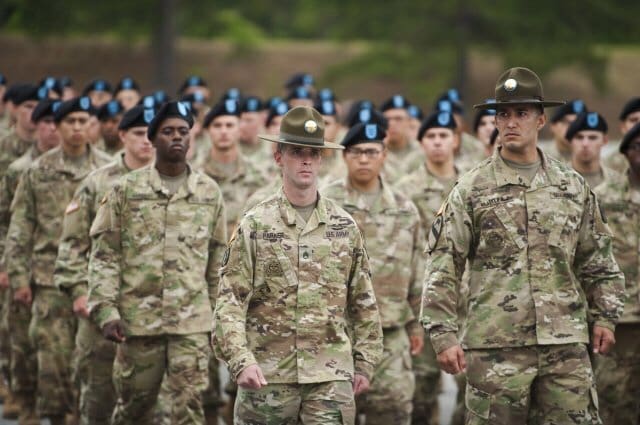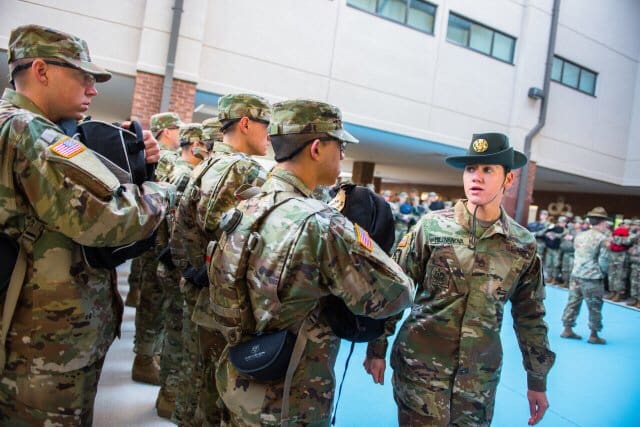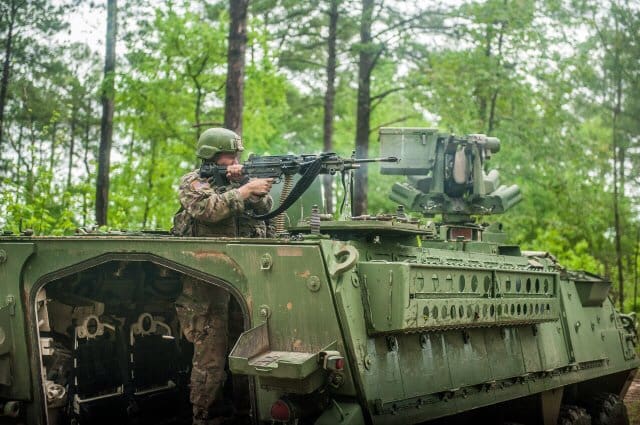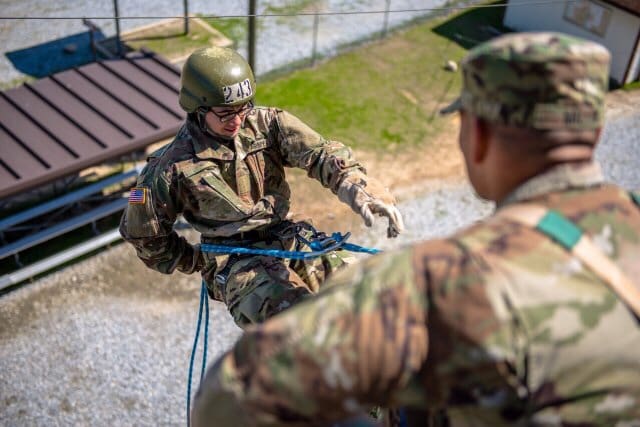WASHINGTON — In 2019, the Army will extend one-station unit training for Infantry Soldiers from 14 weeks to 22 weeks. Changes to the program are meant to increase Soldier readiness, making them more lethal and proficient before they depart for their first duty assignment, according to the Infantry School commandant, Col. Townley R. Hedrick.

Col. Jackson J. Seims relinquishes command of the 2nd Battalion, 54th Infantry Regiment, 198th Infantry Brigade to Col. Thomas J. Siebold Wednesday, April 27, 2016 at Kanell Field, Fort Benning, Ga. In 2019, the Army will extend one-station unit training for Infantry Soldiers from 14 weeks to 22 weeks. In 2019, the Army will extend one-station unit training for Infantry Soldiers from 14 weeks to 22 weeks. (Photo Credit: U.S. Army photo by Patrick A. Albright, Maneuver Center of Excellence)
The new OSUT program will include expanded weapons training, increased vehicle-platform familiarization, extensive combatives training and a 40-hour combat-lifesaver certification course, said Hedrick.
Further, the change will include increased time in the field during both day and night operations and include an increased emphasis on drill and ceremony maneuvers.
A NEEDED CHANGE
For the past 44 years, Infantry Soldiers were trained in a 14-week program of instruction. Ten weeks were allocated to basic military training, and an additional four were reserved for training Infantry-specific skills, Hedrick said. The Infantry career field makes up approximately 15 to 17 percent of the total force.

U.S. Army Infantry Soldiers-in-training assigned to Alpha Company, 1st Battalion, 19th Infantry Regiment, 198th Infantry Brigade, begin their first day of Infantry one-station unit training (OSUT) February 10, 2017 on Sand Hill, Fort Benning, Ga. In 2019, the Army will extend one-station unit training for Infantry Soldiers from 14 weeks to 22 weeks. (Photo Credit: U.S. Army photo by Patrick A. Albright, Maneuver Center of Excellence)
Discussions about changing OSUT began shortly after Secretary of Defense James N. Mattis identified the need to re-establish readiness and build a more lethal Infantry force, Hedrick said. And the Army Vision, recently published by Secretary of the Army Mark T. Esper and Chief of Staff of the Army Gen. Mark A. Milley, reinforces the defense secretary’s priority.
“Extending OSUT is about increasing our readiness and preparing for the future,” Sgt. Maj. of the Army Daniel A. Dailey said. “This pilot program is the first step toward achieving our vision of the Army of 2028. With more time to train on critical Infantry tasks, we’ll achieve greater lethality.”
In response to the increased focus on readiness, specifically within the Infantry force, leadership within the U.S. Army Infantry School approached the 198th Infantry Brigade, which trains all Army Infantry forces, and asked what could be done to make better Infantry Soldiers.
“We asked them if they had a longer training pipeline, what could they do with it,” Hedrick said.
In turn, the U.S. Army Maneuver Center of Excellence and the Infantry School started a combined effort with the 198th Infantry Brigade and the U.S. Army Training and Doctrine Command to develop an improved 21-week OSUT program. After consulting with the Army chief of staff, however, the combined OSUT team was directed to extend the new program to 22 weeks and include combat water survival training, he said.
The preliminary 22-week OSUT pilot program is slated to start this July with a graduation date scheduled for December, the commandant added.
The new 22-week OSUT should begin in 2019, sometime between July and October.
With the upcoming 22-week course, the Infantry School has already identified what new Soldiers will be part of the improved training, Hedrick said.
“U.S. Army Recruiting Command has already gone back to those identified personnel, regenerated their contract, and let them know that they would be part of the first classes to execute a new and improved training program,” Hedrick said.
THE NEW PROGRAM
Under the new OSUT program, Soldiers will get more training with their M4 rifle and increased hands-on experience with the M240 machine gun and the M249 squad automatic weapon.
“So across all the Infantry weapons, they will get more bullets,” Hedrick said. “And they will also shoot more at night, rather than just doing a day familiarization fire.”
In addition to increased weapons training, Soldiers will receive more field training experience, including tactical training repetitions that focus more on squad formations during day and night operations, he said. The goal is to help trainees understand where they fall within a fire team or rifle squad and make them more proficient while operating in the field.
“We looked at land navigation and individual Soldier skills,” Hedrick said. “Under the new course, a Soldier will do an individual day and night land navigation course on their own. They will also do a basic combative certification. That improves the mental and physical toughness of Soldiers coming through the Infantry OSUT.”
Additionally, the Infantry School has added six days of vehicle platform training to the new program. Under the 14-week program, Soldiers only received one day of training with their assigned vehicle. During the new course, Soldiers assigned to a Stryker or Bradley unit will learn how to drive and perform maintenance on their assigned vehicle.

A U.S. Army Infantry Soldier-in-training assigned to Alpha Company, 1st Battalion, 19th Infantry Regiment, 198th Infantry Brigade, engages the opposing force (OPFOR) May 2, 2017, with a M249 Squad Automatic Weapon (SAW) on a Stryker to provide support-by-fire during a squad training exercise, Fort Benning, Ga. In 2019, the Army will extend one-station unit training for Infantry Soldiers from 14 weeks to 22 weeks. (Photo Credit: U.S. Army photo by Patrick A. Albright, Maneuver Center of Excellence)
Furthermore, a more significant emphasis on drill and ceremony has been built into the new curriculum.
“It is all about conditioning, following commands and working as a unit, so you will see an increasing level of discipline through drill and ceremony,” the commandant said. “We think this gets us to the objective of a more expert and proficient Soldier.”
Changes to the program create an extended and more gradual training process to help decrease injuries caused by lack of nutrition or poor conditioning, Hedrick said
“We’ve developed a set of metrics, with the U.S. Army Research Institute for Behavioral and Social Science Solutions to try and evaluate how the Soldiers are doing during the 22-week pilot program versus the 14-week program,” Hedrick said. “We’ve got an evaluation plan to try and look at ourselves and see if the product coming out has an improved proficiency — like we think it will.”
MANNING AND FUTURE OSUT CHANGES
With an increased time of training, the Infantry School must expand from five to eight battalions to ensure the same annual throughput of approximately 17,000 well-trained Soldiers. Fortunately, resources and facilities are available at Fort Benning to support the new program, Hedrick said.
Additionally, the Infantry School has been working with TRADOC to ensure they have enough drill sergeants in place to meet the 2019 launch date for the new 22-week OSUT.

A U.S. Army Infantry Soldier-in-training assigned to Alpha Company, 1st Battalion, 19th Infantry Regiment, 198th Infantry Brigade, rappels off Eagle Tower March 4, 2017, on Sand Hill, Fort Benning, Ga. In 2019, the Army will extend one-station unit training for Infantry Soldiers from 14 weeks to 22 weeks. (Photo Credit: U.S. Army photo by Patrick A. Albright, Maneuver Center of Excellence)
Under the current 14-week program, three drill sergeants are responsible for training a platoon of 60 Soldiers. For the 22-week program, the Infantry School is looking to augment OSUT companies with six additional Infantry instructors.
Overall, the additional instructors provide a better student-to-instructor ratio during certain aspects of the course, the commandant said.
At the conclusion of the 22-week pilot, the OSUT team will review the results and determine what parts of the program need to be re-sequenced. The pilot will also be used to determine the list of tasks assigned to each instructor, Hedrick said.
In addition to the changes to the Infantry School’s curriculum, the Army is looking at extending other OSUT programs. Currently, the U.S. Army Armor School and U.S. Army Engineer School are performing internal analyses of their curricula to determine what resources will be needed to extend their own programs.
“Extending Infantry OSUT will allow us to allocate more time to honing the necessary skills to provide greater capability to our commanders,” Dailey said.
With our first major change to Infantry training in 40 years, he said, we are investing in future Army readiness, which will ensure we are prepared to deploy, fight and win our Nation’s wars when called upon to do so.
By Devon L. Suits, Army News Service


I wish I had gone through this longer basic rather than the short one from 2007. My question is with the vehicle familiarization, what are the light infantry guys going to do? More ruck marches? The article says that soldiers going to Stryker or Bradley equipped units are going to those particular segments, and obviously the mortar guys are going off to do their stuff… but I don’t see what the light infantry guys are going to be doing.
I don’t know about the extra D&C, but since boot polish and ironing went away I’ll allow it.
Soldiers of tomorrow’s war will need every advantage we can front load into them.
Did your DnC help you fight the gwot? We skipped DNC during the surge. Didnt seem to make me less lethal.
It’s all about what they actually do with the added weeks. We know the Army is good at meaningless staff-speak and Powerpoint promises. Actual mission accomplishment, the record as of late is a bit more, say, spotty.
Use of words like “honing” and “metrics” do not fill my heart with hope that they will get this right.
Is this worthwhile? Marksmanship? Or just time taken away from training with their actual unit that they might learn something at?
If anything, it’s more time before they’ll be blowing their paychecks on Mustangs, strippers, and booze.
Spanks, It’s necessary. What training do you think they’re missing at their unit? When’s the last time you been in a unit training cycle and saw how little individual training is there to support these large collective events that LTC/COL are evaluated on? Only a few people have the experience to get the resourcing, planning and execution of really good training for their people at the mastery level like 20+ years ago when everyone stayed for years in the same community. The force is too ‘broadened’ to have the continuity to get it right, most times.
Attack is hitting the nail on the head here.
This is what I think of
https://terminallance.com/terminal-lance-character/itb/
According to Terminal Lance, it’s “POG” not “Pogue”.
https://terminallance.com/2014/08/29/terminal-lance-nco/
Didn’t he quit because the Marine Corps was too hard? Sounds like a Pogue to me.
I’m pretty sure in the 80s infantry AIT was 8 weeks. Apparently it was 8 or 9 weeks during Vietnam. So I’m wondering how they get to claim it was 14 weeks for the last 44 years. Maybe it’s been that way recently as they need the extra time to cover the whole social justice activist part that CoS “And as horrific as this tragedy was, if our diversity becomes a casualty, I think that’s worse” felt was so essential to his vision of the Army.
The 14 weeks is referring to the length of OSUT not AIT
Iheart is on point, most do not know the difference in initial entry training. One Station Unit Training is mainly for combat arms MOSs, everyone else attend an 8 wk BCT (basic combat training) then head off to their 10-37 wk AITs for their specific MOS.
is that going to be the same for 19D/19K, too ?
“Currently, the U.S. Army Armor School and U.S. Army Engineer School are performing internal analyses of their curricula to determine what resources will be needed to extend their own programs.”
Not yet.
Will more infantry training make our infantry better?
Reminds me of the old PowerThirst commercials on youtube – Do you want to be SUPER INFANTRY?! Try SUPER INFANTRY SCHOOL!! For people who need GRATUITOUS AMOUNTS OF INFANTRY!! ITS LIKE ADDING INFANTRY TO AN ELECTRICAL STORM!! … and so on…
Sounds like the Army is trying to catch up to the Marine Corps. I couldn’t believe what I was reading when I read that Army Infantry went through “a 14 week course”, ten for basic training and four for more specific infantry skills!!! Recruit Training is 13 weeks at Parris Island or San Diego and then another three months at SOI-ITB.
Definately the differences in priorities of the services are on display. The Army has been about mechanized and armor units since World War II, up until recently, while the Marine Corps raison d’etre is to provide “Shock Troops for the Republic”.
So good I had to post it twice.
https://terminallance.com/2014/08/29/terminal-lance-nco/